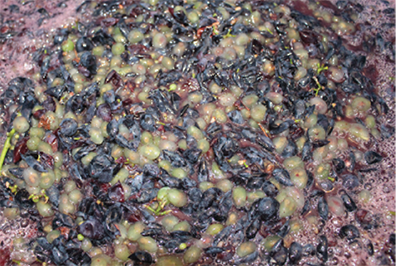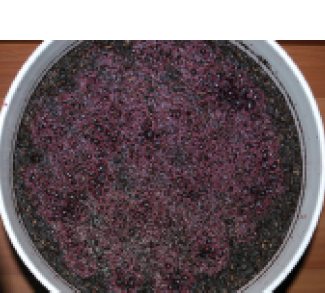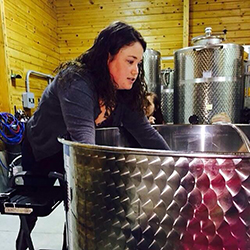 Field blending is the process of harvesting an entire block of varied grape varieties at the same time and co-fermenting them together as a blend. This is different from the more common practice today of harvesting an individual variety, vinifying it, and then blending it with other finished wines just before bottling based on side-by-side taste testing. In other words, field blending is the process of blending wines in the vineyard, not in the winery. Field blending, although not common, is deep rooted (pun intended) and still utilized in wineries throughout the world.
Field blending is the process of harvesting an entire block of varied grape varieties at the same time and co-fermenting them together as a blend. This is different from the more common practice today of harvesting an individual variety, vinifying it, and then blending it with other finished wines just before bottling based on side-by-side taste testing. In other words, field blending is the process of blending wines in the vineyard, not in the winery. Field blending, although not common, is deep rooted (pun intended) and still utilized in wineries throughout the world.
One should almost think of field blending as an insurance policy to protect the winemaker for what Mother Nature may throw at the vineyard from year to year. In a mixed block of Cabernet Sauvignon, Cabernet Franc, and Merlot, for example, in a relatively cold year the Cabernet Sauvignon may not mature to perfect ripeness while the Cabernet Franc and Merlot will. When these are blended properly, the resultant wine could be very palatable even though one of its components was far from stellar.
Field blending is still practiced in many vineyards throughout Europe, resulting in wonderful wines. Field blends persist today in many Portuguese vineyards. Chateauneuf-du-Pape in the Southern Rhône Valley of France is one region known for field blend wines made from as many as 13 or more grape varietals. In the Northern Rhône it’s common to co-ferment a small amount of Viognier with Syrah. Italian Chianti is principally made from Sangiovese, but historically it was planted and blended with a host of other traditional grape varieties to give the finished wine more dimension.
Field blending is not limited to Europe. During the Gold Rush in California many Europeans arrived to try to make their fortunes. With them they brought thousands of grape cuttings of varied varieties that were planted together in their vineyards. They picked all these grapes at the same time and co-fermented them. This philosophy still persists today in some vineyards in California. In fact, this is a common theme in old-vine Zinfandel vineyards that other grape varieties like Petite Sirah, Carignane, and Alicante Bouschet are planted in the same block for co-fermentation. Some of the California wineries employing this approach are Ravenswood Winery, Ridge Vineyard, Bucklin Old Hill Ranch, and Carlisle Winery and Vineyards. Scattered field blend vineyards are all around California. They are more common in the earliest planted regions such as Sonoma County and Napa Valley, but they can also be found in Amador County, Mendocino County, Lodi, the Central Coast, and Southern California.
Why do I field blend?
A good blend can bring out the extraordinary qualities of ordinary grape varieties. In addition, field blending arguably builds a higher level of complexity in the resultant wine. Additional flavors and aromatics are released from the varied varieties when co-fermented than if they were vinified individually.
I like to use the world of cooking as an analogy of this enhancement of flavors and aromas. I call it the “more flavorful stew concept.” Let’s for a moment take a beef stew and think about taking each of its components out and cooking them separately. Let’s sauté our onions, carrots, and potatoes and put them aside. Let’s braise our beef and put it aside. Let’s make some tomato sauce and put it aside. When each component of the stew is complete, we’ll mix them together, warm them up a bit and serve to our guests. Now let’s make another stew all in the same pot. Sauté our vegetables, sear our beef, add our sauce and let it cook at a low temperature for a number of hours all together. Now let’s serve that to our guests for them to try side-by-side with the other stew. Both have the same exact components, but which one is the most flavorful and harmonious? Obviously, if you cook a lot like I do, the stew that was cooked together, where all the ingredients had the ability to bring their respective qualities and attributes to the mix, greatly enhancing the overall end product. I think of this in the same exact way when making my wines and this is why I use the field blending technique when working with my grapes.
What varieties?
As a cold-climate grower, I learned early on that I was limited in what grape varieties I could hope to grow and harvest long-term here in the Hudson Valley of New York. We have a relatively short growing season and some cold winters – think Polar Vortex. With an eye on success and limiting my stress from year-to-year in my wine growing hobby vineyard, I focused primarily on hybrid grapes. After all, hybrid grapes have been developed over the years for the very purpose of trying to promote successful grape growing in areas that are not conducive for growing Vitis vinifera varieties.
But are hybrid grapes good for making quality wine? This is a debate that has varied camps and is not the topic of this article. It could get heated! From my experience, I will tell you that hybrids have their pluses and minuses. Their biggest positive for me is that they flourish in my home vineyard. As long as I practice proper viticulture and maintenance, they regularly offer up a bountiful crop of quality fruit. Their negative, depending on your palate, is they may be lacking in some attributes that you may want in your wine. That is where field blending comes in. I’ll get into that in more detail a bit later.
But first, let’s start with how I chose the varieties to field blend. The most important features for me were flavor and aromatic attributes that could be expected from the resultant wines, ease of maintenance, and when the grapes would mature. The expected maturity of the varied varieties is a key criteria when trying to pick varieties for field blending. You want them to all be close in maturity at the time of harvest. One of my planted varieties, Marquette, didn’t meet this criteria. It actually reaches maturity in the early to mid-season, versus late season for most everything else. I added this grape variety, however, due to its ability to achieve very high levels of sugar (Brix) that none of my other planted varieties could ever hope to achieve. This helps in reducing the level of chaptalization (pre-fermentation sugar addition) I need to do in order to achieve my target alcohol levels for my wines. So how do I field blend a variety that matures a number of weeks prior to all my other varieties? I harvest, process, and freeze the must and hold it until harvest date for the balance of the vineyard.
In addition to Marquette, hybrids I have planted include DeChaunac, Corot Noir, Noiret, and Vidal Blanc. I have two other varieties planted as well — Concord, a native American variety, and Cabernet Franc, a Vitis vinifera variety I recently added. Yes, vinifera! Cabernet Franc has been grown successfully in other areas of New York with moderating winter temperatures (the Finger Lakes, Long Island, and along Lake Ontario). Here in the Hudson Valley (including at a neighboring commercial winery), Cabernet Franc is beginning to become a popular variety. Due to these pioneers, and my desire to add additional complexity to my field blend red wines, I decided to give Cabernet Franc a try. The next few years will tell me if it was a wise decision or not. A bit more detailed description of my planted varieties is provided in the side bar on page 39.
The process
The process is really an understanding that when employing field blending the wine is truly made in the vineyard and not the cellar. With this in mind, what I do, or don’t do, in my home vineyard over the season is paramount to what I can expect from my wines that vintage. As most wine growers do as harvest approaches, I start to employ on-going sampling and analysis techniques in order to determine when that all-important harvest day will be. I measure Brix, pH, and titratable acidity (TA) as well as taste and inspect the grapes along the way. I will say that field blending can be a bit more artistry than the process of blending after vinification. Field blending decisions are typically made by the vineyard manager along with the head winemaker. They will determine the harvest date and set the future of the resultant wine in stone (minus some minor winemaker tricks of the trade along the way). In post-fermentation blending, a panel is typically utilized to determine the perfect blend from the selected wines. There is much more flexibility and variability in the options in this process. It sounds more scientific doesn’t it? It is, which is why post-fermentation blending is the preferred method for blending today. I, however, enjoy the artistry associated with field blending. In fact, although I measure Brix, pH, and TA, I decide when to harvest in my hobby vineyard almost entirely on taste and physiological maturity and ripeness. After growing grapes for a number of years you start to become in tune with the varieties you grow. Just by appearance and taste you know in your gut if it is time to harvest and what you can expect from a particular variety.
That brings up the other part of the artistry and goes back to the “more flavorful stew concept.” Which grapes do I blend together and why? There are a number of things I consider: What wine style am I after? Would this variety work in that vision? Will the variety add something to the blend that is missing to achieve the desired outcome? Will the variety complement the other variety(ies) in some way?
Historically, I have found that Noiret and Corot Noir blend very well together. Noiret brings some spiciness while Corot Noir brings more fruit and mid-palate weight to the blend. The two lack a bit in acidity and sugar; Marquette fills those needs nicely. Now here is where I stray from true field blending. Recall that field blending is by definition all the grapes from the same vineyard plot. I, however, also utilize grape varieties from California in my blends — a completely different terroir. Why? In trying to achieve the vision for the wine I am trying to create, there are certain attributes that my homegrown hybrids just can’t bring to the “stew.” Here is where sunny California varieties come in handy. First of all, I can time delivery of the grapes with my harvest date. That’s pretty key for field blending. Hybrids are generally limited in tannins for my palate and vision for my dry red wines. They are also pretty limited in the grape sugars they can develop in my home vineyard, except of course for Marquette. So to the rescue are the California Cabernets, Syrah, Zinfandel, and Pinot Noir.
The Pinot Noir and/or Syrah I typically blend with the Noiret, Corot Noir, and Marquette. I look at this as complementary to the fruitiness and spiciness of my hybrid varieties while bringing in the greatly needed grape sugars and helping to balance out the overall acidity of the resultant must. The Cabernet Sauvignon and Cabernet Franc blend beautifully with my DeChaunac. They again provide grape sugars, but also the tannins that DeChaunac is lacking. DeChaunac adds a wonderful complexity and earthiness to the blend that the Cabernets just don’t develop on their own. I have blended Zinfandel with Cabernet Sauvignon and DeChaunac. It makes a robust and palatable wine but I feel Zinfandel can overpower the blend.
Overview
Field blending is not for everyone. If you want much more control and flexibility with your blends, then post-fermentation blending is more for you. If you liken yourself to be more of an artist and like to experiment and let your palate make the decisions a bit more than analytical results, then field blending may be a great way for you to make your blended vintages from year-to-year. I do, again, fully believe that co-fermentation brings out flavors and aromas that would not exist if varieties were vinified on their own. This provides for much greater depth and complexity in the wine.
This brings me to my final point. You don’t have to have a vineyard at all to field blend. Buy a few cases of this and a few cases of that, process them, and co-ferment them. If you can, try purchasing the grapes from the same AVA (or even vineyard) to mirror the true field blending process. Maybe even buy enough so you can blend some pre-fermentation and also ferment what is left as varietal wines. Do your post-fermentation blending with these varietals and then compare them side-by-side with your co-fermented wine after a couple of years of aging. You be the judge of which approach you like better.
MY VINEYARD VARIETIES (sidebar)
Concord – A grape variety that most people are familiar with in the United States; albeit not so much for wine (think Welch’s). Concord is a native American variety from the Vitis labrusca species of grapes. This is the variety I cut my teeth on when making homemade wines, so it is near and dear to me. Concord typically has a moderate level of acidity and matures mid- to late-season in my vineyard with limited tannins. Wines made from this variety have a distinct “grapey” flavor, but when blended with more robust and tannic wines can help develop a more fruit-forward blend.
Marquette – One of my newest additions to my home vineyard, Marquette is a hybrid grape developed by the University of Minnesota. It is very hardy and can handle extremely low winter temperatures. It varies greatly from the other varieties I grow in the level of Brix (sugar) it can develop. This grape can easily achieve a Brix in the upper 20s and matures much earlier than the balance of my varieties. Great to bring some extra grape sugar to my blends! It is a high-acid grape that dictates that I let it hang as long as possible before harvesting to try to bring this level down. It has moderate tannins. This variety develops into a medium-bodied wine with aromas of cherries, blackberries, and blackcurrants; with tobacco, leather, and spicy pepper notes.
DeChaunac – One of my most notable work-horses in my vineyard. DeChaunac is a French-American hybrid grape that is highly reliable and productive. It typically matures mid- to late-season in my vineyard with a moderate acidity and relatively low tannins. Wines from this variety develop complex fruit flavors with underlying elements of red cherries, cooked mulberries, prunes, blackberries, and cinnamon. Its dark flavors also showcase an appealing earthy, mushroom-like flavor profile along with a cigar-box nose. A wonderful blending grape to build complexity.
Corot Noir – A hybrid grape developed in New York by Cornell University. This is the only variety that didn’t require grafting for my terroir. In fact, it performs best on its own roots. It typically matures late-season in my vineyard with a moderate acidity and has well-balanced soft tannins. A great blending grape, in my opinion. It brings many mid-palate aromas of cherry and berry fruits to the blend.
Noiret – Another hybrid grape developed by Cornell University. It typically matures late-season in my vineyard with a moderate to low acidity and light, although well-balanced, tannins. Another great blending grape. It brings overtones of pepper and spice along with raspberry, blackberry, blueberry, cooked plums, and sometimes a hint of mint.
Vidal Blanc – A French-American hybrid, it is the only white grape variety I grow. It is my other work-horse variety. Vidal was originally developed to produce grapes suitable for making Cognac. It developed into a variety that is highly versatile in the winery for the production of table wines along with dessert and ice wines. It makes a great sparkling wine too, by the way. It typically matures late-season in my vineyard with a high acidity. This is one variety I actually don’t blend (although many local and regional wineries do). Wines from this variety are very clean and floral and provide aromas and flavors of pineapple, pear, and apricot, and finish with a touch of citrus.
Cabernet Franc – Yes, vinifera! My only Vitis vinifera variety and most recent planting. The father of Cabernet Sauvignon, this is the most winter-hardy of the vinifera red varieties. It also requires the shortest growing season to achieve ripeness; although it will definitely be the latest variety to harvest in my vineyard and likely become my trigger for harvest date. The local wines I have tasted from this variety, if made properly, have had wonderful flavors of red and black raspberries, violets, plums, cooked blueberries, strawberries, and sometimes cranberries with a touch of spiciness.






